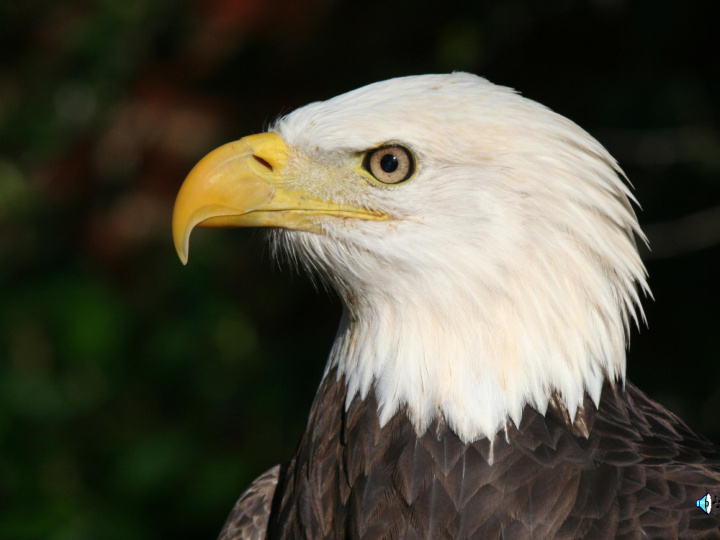



Bald eagle ( Haliaeetus leucocephalus) Location: Audubon Center for Birds of Prey, Orlando, Florida Rehabilitation injured raptors Regionally endangered in New Brunswick, Canada since 1976 The 1992 Atlas of Breeding Birds of the Maritime Provinces recorded 40 pairs in NB Often seen diving at Mergansers, trying to get the food They reduced / disappeared 1945-1973 due to DDT bioaccumulation / egg shell thinning…and shooting! (now illegal) Excellent come back since ban on DDT in 1970's Takes 4-5 years to develop white (not a Golden Eagle!)
Barred owl ( Strix varia ) Location: Taken at Audubon Centre for Birds of Prey In 1992, 1,500 +/- 300 pairs were recorded in New Brunswick Common in the Miramichi, NB area Call: Who cooks for you, who cooks for you all / Cackles, hoots, caws, gurgles Nests in cavities in deciduous trees and will use nest boxes Can see 100x better than us in dark
Great blue heron ( Ardea herodias ) Location: Gatorland, Orlando, Fla. Common – In 1992, 1,400 pairs recorded in NB Common in wetland and marshes Long lives, up to 17 yrs Bill snaps during courtship
Pileated woodpecker ( Dryocopus pileatus ) Location Miramichi, NB Between 2 houses ! Sometimes seen on telephone poles In 1992, 2,800 +/- 1,800 recorded in NB Uses large diameter trees Nest is a 3-6 week excavation project ! Many other birds and mammals depend on the cavities made by the Pileated (ducks, falcons, owls, flying squirrels) 1 pair needs a 80 acre territory to settle (mature forest) Very loud resonant drumming
Common yellowthroat ( Geothlypis trichas ) This is a male. The female has no mask. Taken in Miramichi, NB – in a marshy area Fast-moving, energetic Lives in wet meadows, alder clumps, fields. Nests on the ground and is very territorial One of most widespread warblers in the Canadian Maritimes In 1992, 330,000 +/- 84,000 pairs were recorded in NB Call: Witchety witchety witchety witch
Cedar waxwing ( Bombycilla cedrorum ) Call: Tseee-tseee-tseee Common migrant and breeder In 1992 , 57,000 +/- 17,000 pairs were recorded in NB, Canada Travels in flocks Love berries, and also catches flying insects
Common merganser ( Mergus merganser ) Female with over 19 young. She is babysitting for other females who are absent. Common in local NB rivers In 1992, 700 pairs were recorded in NB They form large migrating groups The male has a glossy green head with no crest and white plumage They nest in tree cavities, on the ground, and in nest boxes Like to eat trout and young salmon. They can dive up to 9m Years ago, people were hired to shoot them because they were considered a threat to the salmon population.
Great black-backed gull ( Larus marinus ) Common year-round in NB In 1992, 1,500 pairs recorded in NB Nest in colonies, but some isolated pairs can be found This pair shared the log buttress with several cormorants These gulls are large, bold, and aggressive – they usually get first dibs at food They out-compete other smaller species. They are a predator to terns and puffins. They have a red spot on their lower mandible. The young pecks at it for food and the parent regurgitates.
Red-breasted nuthatch ( Sitta canadensis) A ragged parent feeds its new fledgling A common year-round resident in NB In 1992, 53,000 pairs recorded Eats, suet, black sunflower seeds Travels headfirst down tree trunks Smears the nest cavity entrance with pitch from spruce and fir trees (to keep ants and other parasites out) Eats pine and spruce seeds during winter
Northern parula ( Parula americana ) Common in NB Has a sock-like nest hanging from tree branches (made of moss and "old man's beard") Lives in older forests and likes to stay up in canopy In 1992, 140,000 pairs recorded in NB
Threats to Birds Laws between 1900-1970 helped protect several species Over 1,100 bird species are "at risk" – 11% of all species 200 may disappear within 20 years No. 1 threat is habitat loss and fragmentation Millions of acres lost in central and SA (agriculture, cattle, coffee, sugar cane, soy, etc..) NA - urbanization and land development Others: Shooting / incidental trapping / power lines Pesticides House cats, window collisions, high-rises, cars
Global Warming Caused by the burning of vast amounts of fossil fuel, emitting CO2 into the atmosphere (coal, oil, gasoline…) Ranges, migration patterns and reproductive cycles have already begun to shift for a number of species Species that are commonly migrating south are now seen more in northern areas Risks: Reproductive cycle can become "out of sync", i.e. young may not hatch at times of maximum insect emergence Sudden cold snaps, food shortage Birds may need to adapt at a much faster rate than in the past
Things We Can Do Land conservation (donations, easements) More responsible land development Reduce our carbon footprint Cars, electricity, landfills Less energy, fossil fuels Live carbon-neutral (offset CO2 emissions) www.climatecrisis.net http://www.epa.gov/climatechange/ http://www.ec.gc.ca/eco/main_e.htm Consumerism driving environmental collapse Edward Burtinsky – Manufactured Landscapes Feed the birds and give them shelter ! Books by Sally Roth, Audubon
Resources Stokes Field Guide to Bird Songs Birds of Atlantic Canada – Roger Burrows Atlas of Breeding Birds of the Maritime Provinces (1992) Cornell U. Ornithology Lab – http://www.birds.cornell.edu/ Hinterland Who's Who – http://www.hww.ca/hww.asp?id=7&pid=1 ABC web site www.abcbirds.org (e.g. global warming articles)
Recommend
More recommend